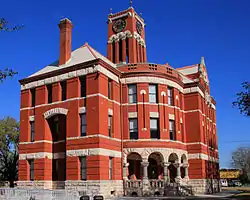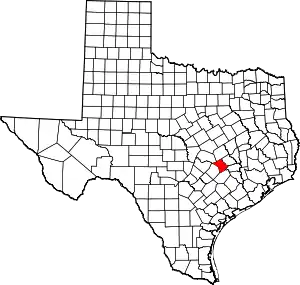Lee County, Texas
Lee County is a county located in the U.S. state of Texas. As of the 2010 census, its population was 16,612.[1] Its county seat is Giddings.[2] The county is named for Robert E. Lee, US and Confederate General.
Lee County | |
|---|---|
 County courthouse in Giddings, built 1899 | |
 Seal | |
 Location within the U.S. state of Texas | |
 Texas's location within the U.S. | |
| Coordinates: 30°19′N 96°58′W | |
| Country | |
| State | |
| Founded | 1874 |
| Named for | Robert E. Lee |
| Seat | Giddings |
| Largest city | Giddings |
| Area | |
| • Total | 634 sq mi (1,640 km2) |
| • Land | 629 sq mi (1,630 km2) |
| • Water | 5.1 sq mi (13 km2) 0.8%% |
| Population (2010) | |
| • Total | 16,612 |
| • Density | 26/sq mi (10/km2) |
| Time zone | UTC−6 (Central) |
| • Summer (DST) | UTC−5 (CDT) |
| Congressional districts | 10th, 17th |
| Website | www |
Geography
According to the U.S. Census Bureau, the county has a total area of 634 square miles (1,640 km2), of which 629 square miles (1,630 km2) is land and 5.1 square miles (13 km2) (0.8%) is water.[3]
Major highways
 U.S. Highway 77
U.S. Highway 77 U.S. Highway 290
U.S. Highway 290 State Highway 21
State Highway 21
Adjacent counties
- Milam County (north)
- Burleson County (northeast)
- Washington County (east)
- Fayette County (southeast)
- Bastrop County (southwest)
- Williamson County (northwest)
Demographics
| Historical population | |||
|---|---|---|---|
| Census | Pop. | %± | |
| 1880 | 8,937 | — | |
| 1890 | 11,952 | 33.7% | |
| 1900 | 14,595 | 22.1% | |
| 1910 | 13,132 | −10.0% | |
| 1920 | 14,014 | 6.7% | |
| 1930 | 13,390 | −4.5% | |
| 1940 | 12,751 | −4.8% | |
| 1950 | 10,144 | −20.4% | |
| 1960 | 8,949 | −11.8% | |
| 1970 | 8,048 | −10.1% | |
| 1980 | 10,952 | 36.1% | |
| 1990 | 12,854 | 17.4% | |
| 2000 | 15,657 | 21.8% | |
| 2010 | 16,612 | 6.1% | |
| 2019 (est.) | 17,239 | [4] | 3.8% |
| U.S. Decennial Census[5] 1850–2010[6] 2010–2014[1] | |||
As of the census[7] of 2000, there were 15,657 people, 5,663 households, and 4,150 families residing in the county. The population density was 25 inhabitants per square mile (9.7/km2). There were 6,851 housing units at an average density of 11 per square mile (4/km2). The racial makeup of the county was 76.59% White, 12.08% Black or African American, 0.46% Native American, 0.24% Asian, 0.03% Pacific Islander, 8.87% from other races, and 1.72% from two or more races. 18.19% of the population were Hispanic or Latino of any race. 35.5% were of German and 8.3% American ancestry according to Census 2000. 80.1% spoke English, 14.4% Spanish and 5.1% German as their first language.
There were 5,663 households, out of which 35.70% had children under the age of 18 living with them, 60.00% were married couples living together, 8.80% had a female householder with no husband present, and 26.70% were non-families. 23.80% of all households were made up of individuals, and 11.70% had someone living alone who was 65 years of age or older. The average household size was 2.65 and the average family size was 3.15.
In the county, the population was spread out, with 28.80% under the age of 18, 9.20% from 18 to 24, 26.30% from 25 to 44, 21.40% from 45 to 64, and 14.40% who were 65 years of age or older. The median age was 36 years. For every 100 females there were 101.60 males. For every 100 females age 18 and over, there were 98.00 males.
The median income for a household in the county was $36,280, and the median income for a family was $42,073. Males had a median income of $30,635 versus $21,611 for females. The per capita income for the county was $17,163. About 9.70% of families and 11.90% of the population were below the poverty line, including 13.70% of those under age 18 and 16.10% of those age 65 or over.
As of the 2010 census, Lee County has a similar ethnic makeup relative to the overall United States.[8]
Politics
Lee County was historically Democratic, although less so than the majority of Texas as it was somewhat allied with the isolated Republican German-American Unionist stronghold centred upon Gillespie and Kendall Counties. It nonetheless voted Democratic in every election up to 1976 except the landslide Republican triumphs of 1956 and 1972, plus the heavily war-influenced elections of 1916 and 1940 when its German-American population was suspicious of the Democratic Party's position towards Germany.
Since 1980, like all of the rural white South, Lee County has become powerfully Republican. No Democratic presidential candidate has won a majority in the county since Jimmy Carter in 1976, although during the drought- and farm crisis-dominated 1988 election Michael Dukakis won a fourteen-vote plurality. In the past five elections the GOP candidate has always passed two-thirds of the county's vote and Donald Trump exceeded three-quarters in 2016.
| Presidential election results[9] | |||
|---|---|---|---|
| Year | Republican | Democratic | Third parties |
| 2020 | 77.4% 6,255 | 21.6% 1,750 | 1.0% 82 |
| 2016 | 76.2% 4,997 | 20.9% 1,372 | 2.9% 189 |
| 2012 | 72.3% 4,507 | 26.2% 1,632 | 1.6% 97 |
| 2008 | 67.6% 4,312 | 31.4% 2,000 | 1.0% 65 |
| 2004 | 68.3% 4,160 | 31.2% 1,899 | 0.5% 29 |
| 2000 | 66.8% 3,699 | 31.3% 1,733 | 1.9% 104 |
| 1996 | 49.0% 2,354 | 41.8% 2,008 | 9.2% 442 |
| 1992 | 41.7% 2,108 | 36.5% 1,847 | 21.8% 1,103 |
| 1988 | 49.6% 2,513 | 49.9% 2,527 | 0.5% 27 |
| 1984 | 64.1% 2,967 | 35.8% 1,659 | 0.1% 6 |
| 1980 | 52.1% 1,803 | 45.7% 1,581 | 2.3% 78 |
| 1976 | 40.8% 1,348 | 58.6% 1,937 | 0.5% 18 |
| 1972 | 66.7% 1,877 | 32.7% 920 | 0.6% 17 |
| 1968 | 36.0% 1,075 | 42.9% 1,283 | 21.1% 631 |
| 1964 | 32.9% 923 | 67.1% 1,884 | 0.1% 2 |
| 1960 | 42.8% 1,048 | 55.9% 1,369 | 1.4% 34 |
| 1956 | 52.8% 1,200 | 46.7% 1,061 | 0.6% 13 |
| 1952 | 48.6% 1,316 | 51.3% 1,389 | 0.1% 2 |
| 1948 | 21.9% 465 | 72.6% 1,540 | 5.5% 117 |
| 1944 | 35.1% 771 | 43.4% 953 | 21.5% 472 |
| 1940 | 54.6% 1,150 | 45.3% 954 | 0.1% 2 |
| 1936 | 19.0% 271 | 80.9% 1,155 | 0.1% 1 |
| 1932 | 5.7% 110 | 94.3% 1,831 | |
| 1928 | 27.6% 449 | 72.4% 1,176 | |
| 1924 | 11.9% 271 | 68.4% 1,561 | 19.8% 452 |
| 1920 | 14.7% 325 | 32.1% 712 | 53.3% 1,182 |
| 1916 | 56.1% 836 | 38.3% 571 | 5.6% 83 |
| 1912 | 13.6% 134 | 69.6% 687 | 16.8% 166 |
Government and infrastructure

The Texas Youth Commission operates the Giddings State School in unincorporated Lee County, near Giddings.[10]
Economy
As of 2004 the Giddings State School, a Texas Youth Commission facility, was Lee County's largest employer.[11]
See also
References
- "State & County QuickFacts". United States Census Bureau. Archived from the original on October 18, 2011. Retrieved December 19, 2013.
- "Find a County". National Association of Counties. Retrieved 2011-06-07.
- "2010 Census Gazetteer Files". United States Census Bureau. August 22, 2012. Retrieved May 3, 2015.
- "Population and Housing Unit Estimates". United States Census Bureau. May 24, 2020. Retrieved May 27, 2020.
- "U.S. Decennial Census". United States Census Bureau. Retrieved May 3, 2015.
- "Texas Almanac: Population History of Counties from 1850–2010" (PDF). Texas Almanac. Retrieved May 3, 2015.
- "U.S. Census website". United States Census Bureau. Retrieved 2011-05-14.
- Patterson, Thom. (July 15, 2011). "Welcome to Little America: Lee County, Texas". CNN. Retrieved July 15, 2011.
- Leip, David. "Dave Leip's Atlas of U.S. Presidential Elections". uselectionatlas.org. Retrieved 9 April 2018.
- "Giddings State School". Texas Youth Commission. Archived from the original on 2011-02-20. Retrieved August 21, 2010.
- "Disruption at the Giddings State School". Texas Youth Commission. October 5, 2004. Archived from the original on 2011-07-22. Retrieved January 20, 2011.
External links
- Lee County
- Lee County from the Handbook of Texas Online